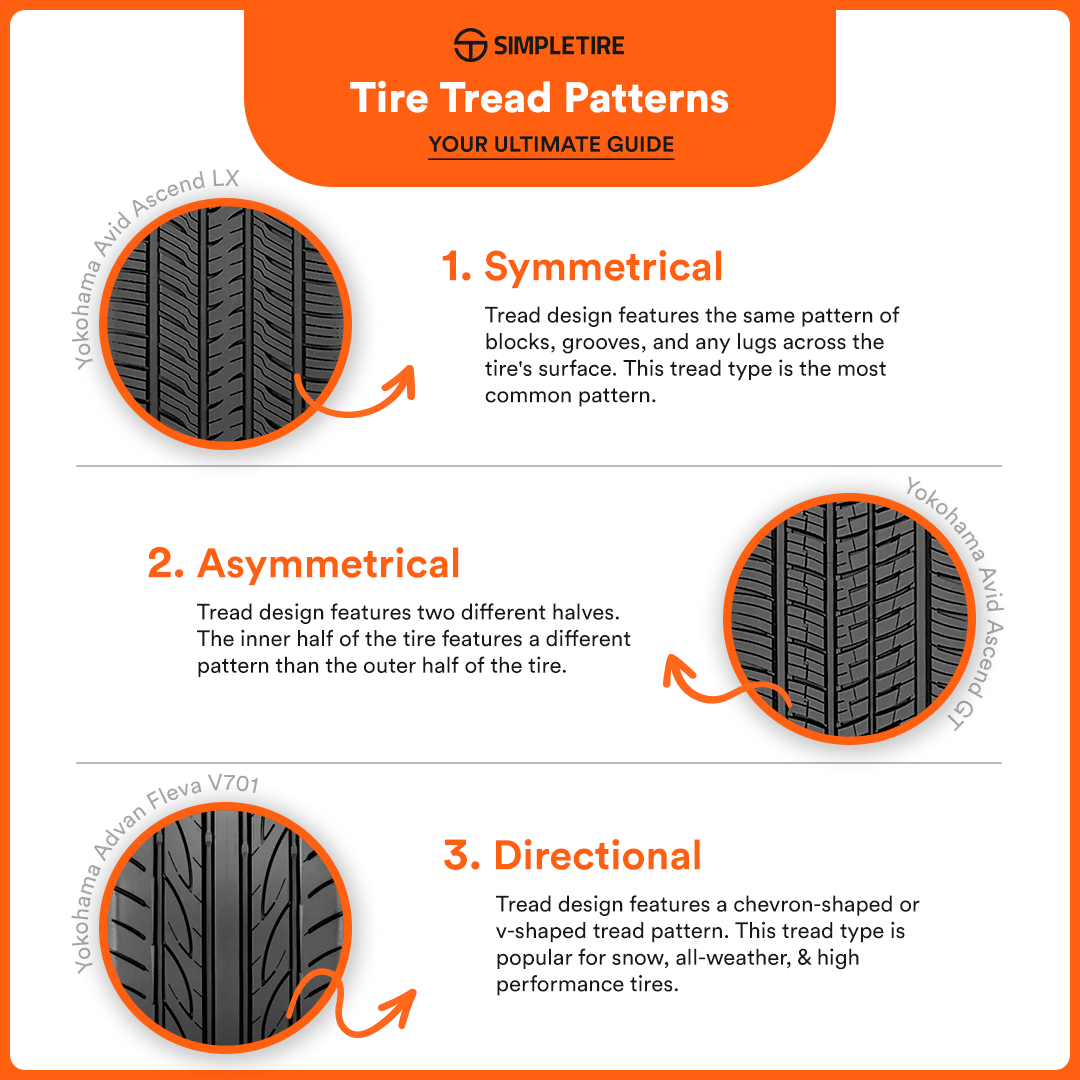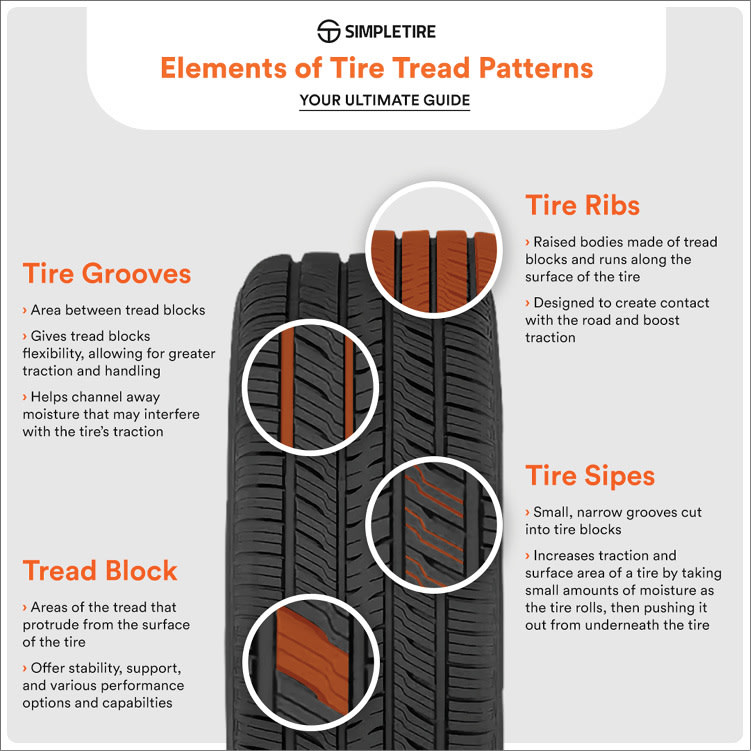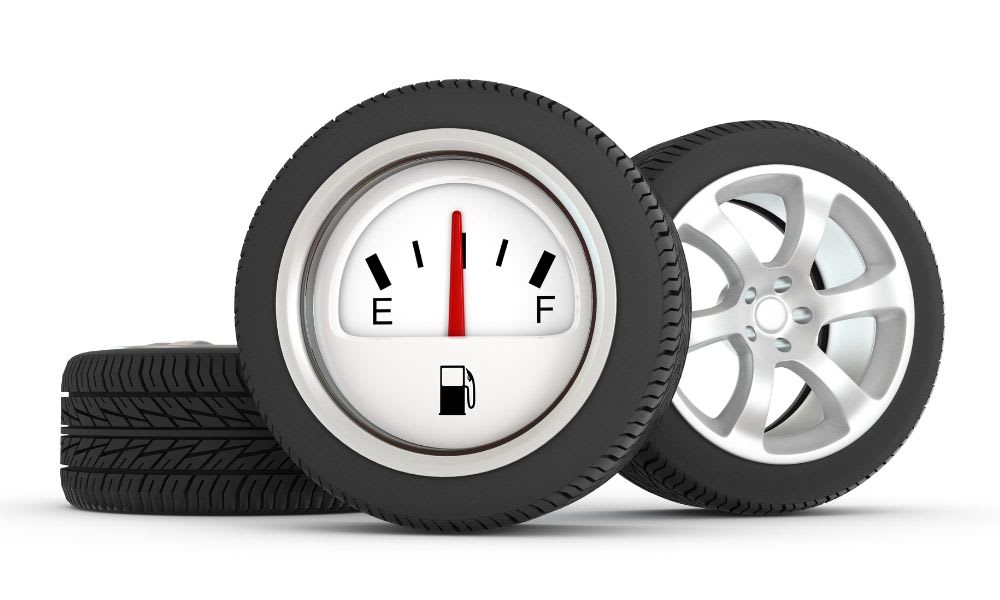Tire News & Information
Understanding Tire Tread Patterns and Their Impact on Performance

Best price guarantee
Tire replacement coverage
24/7 roadside assistance
Easy returns
Tire News & Information


Tire tread patterns are more than just aesthetically pleasing designs on the surface of your tires. They play a crucial role in ensuring your vehicle's safety, performance, and efficiency on the road.
From the intricate grooves and channels to the strategically placed tread blocks, every element of a tire's tread pattern is thoughtfully engineered to optimize traction, handling, and overall driving experience. Understanding how these patterns work can help you make informed decisions when selecting tires for your vehicle.
In this article, we'll dive deep into the world of tire tread patterns, exploring their fundamental components, the science behind their design, and how they impact your vehicle's performance in various driving conditions. Let's unravel the mystery behind those seemingly random scribbles and discover the true power of tire tread patterns.
Tire tread patterns are unique designs molded into the rubber surface of a tire, consisting of an intricate network of grooves, channels, and raised segments called tread blocks. These patterns are carefully engineered to provide optimal traction, handling, and safety across a wide range of driving conditions.
The primary components of a tire tread pattern include:

Ribs: The raised portion of the tread pattern that runs circumferentially around the tire, providing stability and handling performance.
Grooves: The deep channels between the ribs and tread blocks that help evacuate water and maintain grip on wet surfaces.
Tread Blocks: The individual raised rubber segments that make contact with the road surface, offering traction and handling capabilities.
Sipes: Small, thin slits within the tread blocks that provide additional biting edges for enhanced wet and winter traction.
Want to check your tire tread? Tap here to know how to do it
Tire manufacturers invest significant resources into developing tread patterns that strike the perfect balance between performance, comfort, and durability. By manipulating the size, shape, and arrangement of these tread elements, engineers can create tires that excel in specific driving conditions—from dry highways to wet roads and snowy terrain.
The science behind tire tread patterns goes beyond mere aesthetics; it's a complex interplay of material properties, fluid dynamics, and vehicle dynamics. The goal is to optimize the tire's contact patch—the portion of the tire that touches the road—to maximize traction, minimize noise and vibration, and ensure even wear over the tire's lifespan.
As technology advances, tire manufacturers continue to push the boundaries of tread design, introducing innovative features like 3D sipes, variable pitch tread blocks, and multi-wave sipes. These advancements help tires adapt to an ever-wider range of driving conditions while maintaining a smooth, comfortable ride.
In the following sections, we'll explore how tire tread patterns influence specific aspects of vehicle performance, from traction and handling to fuel efficiency and comfort. By the end of this article, you'll have a newfound appreciation for the complex world of tire tread patterns and the vital role they play in your driving experience.
The design of a tire's tread pattern is crucial for its performance on the road, affecting both grip and maneuverability. The detailed structure of tread patterns—including channels and fine slits—enhances the tire’s interaction with the road surface, ensuring a stable and controlled driving experience. These elements play a significant role in how a vehicle responds under various conditions, like wet or dry surfaces.
Channels and fine slits within the tread are vital for maintaining grip, particularly in challenging weather. Channels run along the tire’s surface and efficiently manage water displacement, helping to prevent skidding on wet roads by maintaining contact with the pavement. Fine slits, integrated into the tread blocks, create extra edges that improve grip on slick surfaces, such as wet or icy roads, by increasing the tire’s adaptability and ability to grip the surface.
The configuration of tread blocks—how they are sized, shaped, and arranged—directly affects a tire's stability in corners, as well as its acceleration and braking capabilities. Larger blocks provide a greater road contact area, which enhances grip during high-speed turns. The strategic layout of these blocks ensures even pressure distribution, which contributes to predictable handling and reduces uneven wear. For instance, performance tires often feature asymmetrical patterns, offering optimized dry traction and cornering capability, making them ideal for sports vehicles.
By understanding the impact of tread patterns on these critical performance factors, drivers can choose tires that best match their driving style and typical road conditions. Whether navigating wet urban environments or winding rural roads, selecting the right tread pattern can significantly enhance safety and the driving experience, providing the assurance needed to face any journey.
Buying tires? You need to first understand the how behind selecting a tire

Tire tread patterns are instrumental in optimizing a vehicle’s fuel efficiency and enhancing ride comfort. The design elements of the tread directly affect the resistance a tire faces as it rolls, known as rolling resistance, which in turn influences fuel consumption. By utilizing specific tread configurations, energy loss can be minimized, allowing the vehicle to cover more distance with less fuel.
Innovative tread designs have emerged that focus on reducing rolling resistance by incorporating features that aid in maintaining the tire's shape and minimizing deformation. These designs often integrate advanced materials and streamlined grooves to ensure smooth contact with the road surface. As a result, the energy required to keep the vehicle moving is reduced, leading to improved fuel economy and decreased emissions.
Tread patterns also play a crucial role in providing a quieter, more refined ride. By employing techniques such as varied tread block patterns and noise-canceling technologies, manufacturers can significantly diminish road noise levels. This not only enhances passenger comfort but also contributes to a more serene driving environment, which can be particularly beneficial on long journeys.
Furthermore, advancements in tread compound technology allow for a harmonious blend of grip, durability, and low rolling resistance. These compounds enable tires to maintain their performance attributes while ensuring a smooth and efficient drive. This balance ensures that drivers can enjoy both the benefits of a quiet, comfortable ride and the advantages of reduced fuel consumption.
Selecting the appropriate tire tread pattern requires understanding the driving conditions you frequently encounter. Whether you often face rain-soaked roads, icy paths, or dry highways, aligning the tread pattern with these environments is essential for optimal safety and performance. Different tire types offer distinct benefits tailored to specific conditions.
All-season tires are engineered to manage a wide array of road conditions, making them an ideal choice for drivers who encounter varying weather patterns. These tires provide a balance of features, ensuring dependable performance in both wet and dry environments without sacrificing comfort. The design typically includes moderate grooves and a combination of rib and block patterns that deliver consistent handling throughout the year, providing a practical solution for drivers seeking convenience across seasons.
For drivers who seek enhanced traction and handling on dry surfaces, performance tires are the perfect fit. These tires typically feature intricate tread designs with larger, rigid blocks to maximize grip on dry pavements. This construction enhances cornering precision and braking efficiency, catering to those who enjoy a dynamic driving experience.
Winter tires, conversely, are crafted with unique tread patterns that excel in snowy and icy conditions. They incorporate deep channels and numerous sipes, enhancing grip by cutting through snow and expelling slush effectively. The rubber compounds in winter tires remain pliable in low temperatures, ensuring superior traction when regular tires might slip. These characteristics make winter tires essential in regions with severe winters, providing drivers with confidence in challenging weather conditions.
Tire manufacturers lead the charge in developing cutting-edge technologies to enhance vehicle performance across various terrains and conditions. These innovations reflect a commitment to maximizing traction, efficiency, and ride quality, enabling tires to meet the demands of modern driving with greater precision and adaptability.
Advanced Siping Techniques: New siping methods create intricate patterns within the tread, offering improved grip and stability. These sipes enhance flexibility, allowing the tread to conform to road surfaces more effectively, which results in stronger handling and braking capabilities. Dynamic Tread Blocks: By altering the size and layout of tread blocks, manufacturers can drastically reduce road noise while maintaining traction. This approach minimizes the repetitive patterns that typically generate noise, thus contributing to a quieter ride. Enhanced Water Dispersion: Modern tread designs incorporate features that improve water evacuation from the tire surface, reducing the risk of hydroplaning. These elements increase the number of contact points with the road, providing better performance in wet conditions.
Advanced tread technologies enable tires to perform consistently across various driving environments. As weather patterns become less predictable, these innovations ensure that tires can adapt quickly and efficiently:
Versatile Performance in All Weather: Technologies like dynamic tread blocks and enhanced sipes ensure reliable traction across different weather conditions. This adaptability provides drivers with confidence and safety in changing climates. Optimized Fuel Economy: By minimizing rolling resistance through refined tread designs, these technologies help improve fuel efficiency. The careful arrangement of tread elements maintains an effective contact patch, reducing energy consumption.
The integration of these advanced technologies into tire design represents a significant leap in automotive engineering. By focusing on the details of tread patterns, manufacturers can produce tires that deliver outstanding performance and comfort, preparing drivers to tackle any road condition with ease.

As you embark on your journey to find the perfect tires for your vehicle, remember that understanding tire tread patterns is key to unlocking optimal performance, safety, and comfort on the road. We at SimpleTire are committed to providing you with the knowledge and tools necessary to make informed decisions about your tire purchases. Discover our extensive selection of tires and enjoy a seamless, convenient shopping experience by visiting us today, and let us help you find the best deals for your driving needs.
Search By